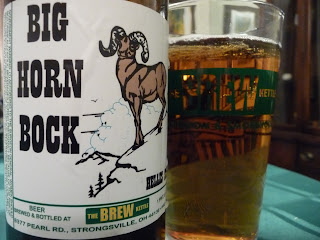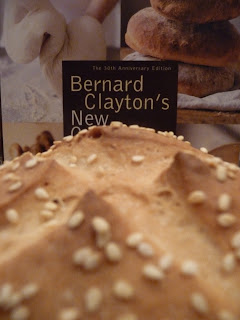
Recently, when Clare and I stopped back in Cleveland for a visit with my parents, they wanted to take us to AMP 150, America's Modern Palate. AMP 150 is a restaurant in the Cleveland Marriott Hotel on West 150th Street. My parents had eaten there a couple of times, and, each time, they loved the food. And, with the restaurant's concept being "farm to table," they knew that I would love this restaurant as well. They were right. I loved this restaurant so much that I decided to do my first ever restaurant review so that I can share some of the great food that I was able to enjoy.
The chef, Ellis Cooley, maintains an ambitious menu, which is executed to near perfection. Guests have the option of ordering dishes -- appetizers, soups and greens, small bites, large bites and gardens (sides) -- but I would strongly suggest the Chef's Choice Tasting Menu. In D.C., most tasting menus offered by chefs in restaurants provide you with four or more courses, usually for a price of $50 per person or more. At AMP 150, you can get a four course meal (which is actually six courses) for $35 per person and a six course meal (which I presume would be eight courses) for $45 dollars. So, this is a great value for what will be a lot of food by the time you are finished.
The Chef's Choice Tasting Menu requires the whole table to put itself in the hands of the Chef and his sous-chefs. They will choose the particular dishes that will be served for each course, all of which come straight off of the menu. You can tell them that certain things are off limits, such as Clare telling them that she does not eat meat, or you can tell them that you are really interested in trying a particular dish, such as when I told them that I would really like to try the grilled sweetbreads. Otherwise, you need not worry, because the Chef and the sous-chefs have a great sense of selecting dishes to present to a table of guests who each have their own likes and dislikes when it comes to food.
 |
| Velvet Mushroom Soup |
The First Starter Course: The first two courses start small but are big on flavor. They are sort of amuse-bouches, intending to wake up the taste buds of the guests. The first starter course is a small little cup of the Velvet Mushroom Soup. The mushrooms are pureed and then cream is added to make a soup that has an incredibly earthy and creamy consistency. The soup is garnished with a little truffle oil and chives.
 |
| Chicken Liver Pate with Apple Jam |
The Second Starter Course: After we finished the soup, the server brought out the second starter course ... crostini. We were given two types of crostini. First, there was the chicken liver pate with apple jam and, second, there was a mushroom pate. I had the chicken liver pate with apple jam, which was delicious. The combination of the chicken and apple jam worked very well together.
 |
| Grilled Sweetbreads |
The Appetizer: After finishing the crostini, the server brought out the appetizers. Each person gets a plate and additional plates are brought for people to share. We were served the Black Mussels, which included Chinese sausage, lemongrass, plum wine, coconut milk and ginger cilantro. The broth was amazing and we requested some bread to dip into the broth to eat. We also had the House Made Ricotta Cavatelli, which was delicious with its brocollini, spec ham and pecorino. The third appetizer was Roasted Cauliflower, with goat cheese, pine nuts and a beet vinaigrette. Finally, we had the Grilled Sweetbreads. The sweetbreads were served with caramelized cauliflower, sweet and sour raisins and micro-cress. The sweet breads were grilled perfectly, with just enough char on the outsides.
 |
| The Salads and Other Dishes |
The Salads: After completing the appetizers, the server brought out two salads and two other dishes for everyone to share. The first salad was the Baby Beet Salad, which included Lake Erie Creamery Goat Cheese, mesculn greens, and a champagne vinaigrette. The second salad we got was the Blood Orange Salad, which included arugula, parmesan and toasted almonds. The third dish we got was the Crispy Duck Confit, with Maytag blue cheese, polenta, caramelized onions and cherries. Finally, we also got the Edamame Falafel, which was surprisingly good and included pickled cucumber, Kalamata olives, preserved lemon and Greek yogurt. All of these salads and dishes were excellent.
The Main Courses: We then turned our attentions to the main courses. Although we were beginning to feel full, the dishes that were brought out were so good that, at least for me, I forgot that I already had more than two courses of food.
 |
| Roasted Free-Range Chicken |
The first main course dish was the Roasted Free Range Chicken. The chicken was roasted to perfection, with crispy skin but very juicy meat. The chicken was served with Catalane bean ragout and rosemary, all of which served as a great base for this dish. If one was to order only a dish, rather than the tasting menu, I would strongly recommend the chicken.
 |
| Wild Striped Bass |
The second main course dish was the Wild Striped Bass. Once again, the dish was cooked very well, with a crispy outer skin and very tender meat underneath. The fish was served with Brussels sprouts, chestnuts, Killbuck Valley Mushrooms, and topped with a Mascarpone foam. Personally, I am not a big fan of Brussels sprouts, however, they were delicious. I am also not a big fan of foam, but, in this case, the foam provided an interesting, but subtle, contrast with the fish.
 |
| Marinated Flank Steak |
The third main course dish was the Marinated Flank Steak. The steak itself was delicious and I am still trying to figure out what was the marinade, because, whatever it was, it contributed a lot of flavor to the meat. The steak was served with fingerling potato "coins," which were a great starchy complement to the meat. The steak was also served with a red wine shallot puree, which provided a nice sauce to add to each bite of the steak.
 |
| Braised Lamb |
Finally, the last main course dish was the Braised Lamb, another dish that I would recommend if you were going to skip the Chef's Choice Tasting Menu and order only one dish. The lamb was cooked perfectly, falling with little effort from the bone. The lamb was served with Jameson Farms Merguez sausage, parsnip and almond hummus, and lentils. All of which were very delicious.
 |
| Sweet Potato Tower |
The Desserts: The last course,was the dessert course. By this time, it was getting a little dark in the restaurant and I could muster only one good picture of the four desserts that were served. The picture is of the Sweet Potato Tower. This dish included brown butter ice cream, bourbon caramel, and pecan praline. Although I am not a big fan of sweets and desserts, this was very good and the perfect way to end the evening. While I don't have pictures for all of the other desserts, and I am having a hard time reading my written notes, all I can say is that they were all interesting and delicious.
Finally, I want to take a moment to thank my parents for taking Clare and I to this great restaurant for such an amazing dinner. AMP 150 provides the food, flavor and presentation one would expect at fancy restaurants in New York City or Washington, D.C., however, it does so in a way that opens that experience to many more people at a much more reasonable price. I am definitely going to add this to my list of restaurants that I would return to whenever I am back in the Cleveland area.
ENJOY!
For more information about the restaurant, check out its
website.









































